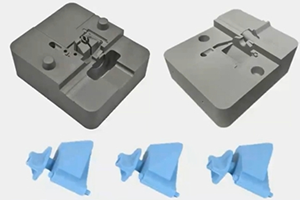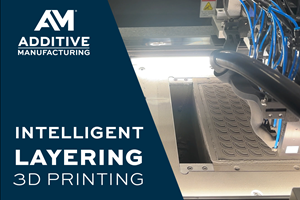Combining Additive and Subtractive Processes for Hybrid Manufacturing
At this point, we are still learning how to combine the two to optimize hybrid manufacturing.
For the past several months, I have focused on directed energy deposition (DED) processes for additive manufacturing (AM), lauding the speed with which it can additively manufacture parts layer by layer. The downside is dimensional accuracy. Whether powder- or wire-fed, DED processes provide a near-net-shape part that will require additional finishing and postprocessing to meet the specified tolerances. The same goes for many parts made with powder-bed fusion (PBF); however, AM parts made with PBF are closer to net shape and will likely need less finishing and postprocessing in comparison to DED. Nonetheless, rarely is an AM part “done” once the build is complete.
In most cases, finishing and postprocessing of an AM part will be accomplished in a separate machine. The AM part will be made on a DED (or PBF) system and then transferred and mounted in a CNC machine (mill or lathe) for subsequent machining and finishing. As you can imagine, it can be a challenge to establish datums and reference points for orienting and locating the part as well as defining tool paths for the CNC machine, especially once the part is separated from the build plate. Designers and engineers are being encouraged to include locating features and references on the part to help establish datums for part orientation and machining.
Meanwhile, manufacturing is advancing to the point in which additive and subtractive processes can be combined into a single system. This is being referred to as hybrid manufacturing, and several commercial systems are now available in the market. For instance, DMG MORI combines DED (powder feed and laser) with five-axis CNC capability in its hybrid manufacturing system. Meanwhile, Matsuura and Sodick took a different approach, combining PBF and CNC capability in their hybrid manufacturing systems, and DMG MORI recently responded with its own PBF and CNC hybrid manufacturing system. Of course, if you don’t want to buy a new system, you can retrofit an existing CNC machining center with the Ambit powder-feed laser deposition head from Hybrid Manufacturing Technologies or add a combination of powder- and wire-feed capabilities to your CNC machine with technology from 3D Hybrid. This enables you to convert a conventional subtractive system into a hybrid manufacturing system with relatively minimal cost and effort.
We are fortunate to have a DMG MORI Lastertec 65 hybrid manufacturing system in CIMP-3D, our metal AM lab at Penn State. The system towers over all of the other equipment in the lab and is a marvel to watch operate. The laser-based powder-feed system offers a spot size of 1.5 mm or 3 mm during a build, enabling 10 to 15 pounds of material to be deposited in an hour. Meanwhile, users can take advantage of the five-axis CNC capability to machine material after it is deposited or they orient the part in different angles during deposition. This removes the need for support structures and enables even more intricate geometries to be printed given the extra degrees of freedom of movement and rotation. The nozzle shown in the figure gives you a sense of how material is added and then subtracted from a part as it is made. The system is equipped with dual powder feeders, enabling you to functionally grade parts by changing the material composition during deposition.
Despite the powerful combination of additive and subtractive manufacturing that is offered in hybrid manufacturing systems, we still have a lot to learn about the technology. For example, what is the best sequence for adding and subtracting material? Can toolpath planning software do collision detection for subtractive features after we have added new features to the part? Meanwhile, how do we maintain dimensional integrity of the machined surfaces as we add new material and the part heats up and distorts? As we subtract material, we shower the part with cutting fluid, which will rapidly cool any features that have been recently added; what do the heating/cooling cycles do to the microstructure and mechanical properties of the part? Finally, what is the powder-capture rate in various build orientations, how does that change as a part rotates around one (or more) of the five axes, and to what extent can powder be captured and reused? You certainly aren’t going to recycle any powder after the work envelope is flooded with cooling fluid!
Hardly anyone knows how to combine [additive and subtractive] and optimize a hybrid manufacturing process. Its promise is more powerful than any single technology alone, but we have just barely begun to explore this new frontier of hybrid manufacturing.
As I tell people who tour our lab, machining professionals know subtractive manufacturing inside and out; they have been doing it for decades. Meanwhile, more and more folks are learning the “ins and outs” of additive manufacturing with metals, but at this point, hardly anyone knows how to combine the two and optimize a hybrid manufacturing process. Its promise is more powerful than any single technology alone, but we have just barely begun to explore this new frontier of hybrid manufacturing.
If you want to learn more about hybrid manufacturing and the challenges companies will face when combining additive manufacturing and subtractive manufacturing technologies, then I suggest you read the technology roadmap from Consortium for Advanced Hybrid Manufacturing Integrating Technologies (CAM-IT) or visit http://cam-it.us/.
Related Content
JuggerBot 3D Awarded $4 Million by Air Force to Develop Large Format Hybrid Additive System
The project focuses on advancing the ability to print a thermoset composite material that can transform the way an aircraft structure is designed, fabricated and sustained for limited-life aircraft.
Read MoreNicolet Plastics Succeeds Using Mantle's Hybrid Metal 3D Printing Method for Mold Tooling
A recent webinar explores Nicolet Plastics’ success using Trueshape Technology, Mantle’s approach to print injection mold tooling. The current challenges this technology addresses and alleviates in additive manufacturing confirms this method is effectively reducing lead times and cost constraints, while producing better inserts.
Read MoreGRM Develops Software for OverHiPP Project to Improve Accuracy of Digital Twins
As part of an OverHiPP study, GRM has created software that enables users to virtually model and analyze 3D printed structures at a level of detail never seen before — an accurate digital twin can now be generated, enabling precise design decisions to be made.
Read MoreVideo: Intelligent Layering Metal 3D Printing at 3DEO
Contract manufacturer 3DEO delivers metal parts using Intelligent Layering, a binder jetting-like 3D printing process the company developed and operates internally. Here’s how it works.
Read MoreRead Next
Metal 3D Printing in a Machine Shop? Ask the Marines
A hybrid system combining metal 3D printing with machining gives the Marine Corps perhaps its most effective resource yet for obtaining needed hardware in the field. It also offers an extreme version of the experience a machine shop might have in adding metal AM to its capabilities.
Read More3D Printed Polymer EOAT Increases Safety of Cobots
Contract manufacturer Anubis 3D applies polymer 3D printing processes to manufacture cobot tooling that is lightweight, smooth and safer for human interaction.
Read MoreBike Manufacturer Uses Additive Manufacturing to Create Lighter, More Complex, Customized Parts
Titanium bike frame manufacturer Hanglun Technology mixes precision casting with 3D printing to create bikes that offer increased speed and reduced turbulence during long-distance rides, offering a smoother, faster and more efficient cycling experience.
Read More

















